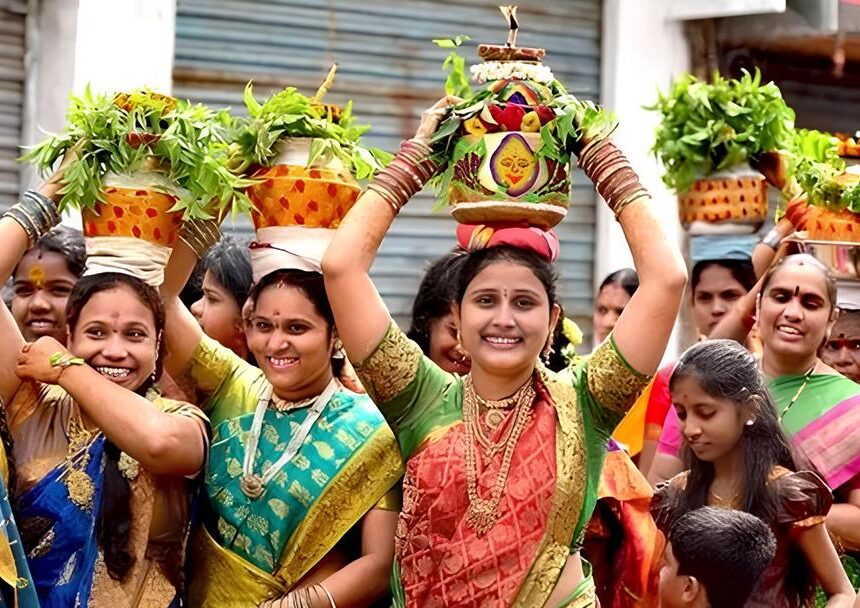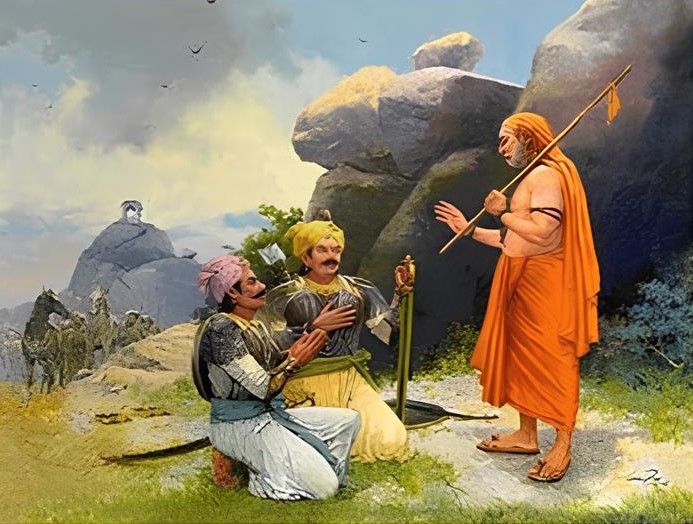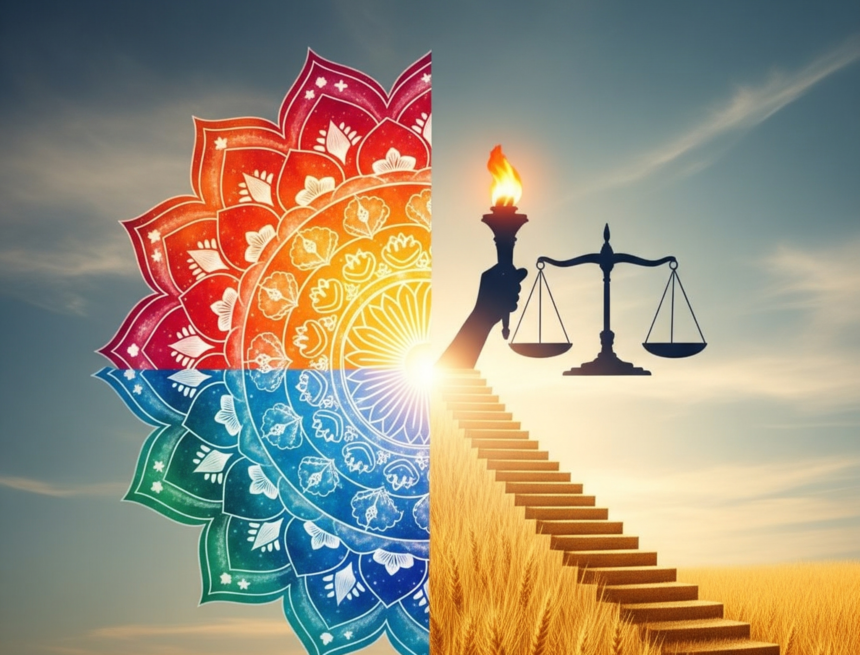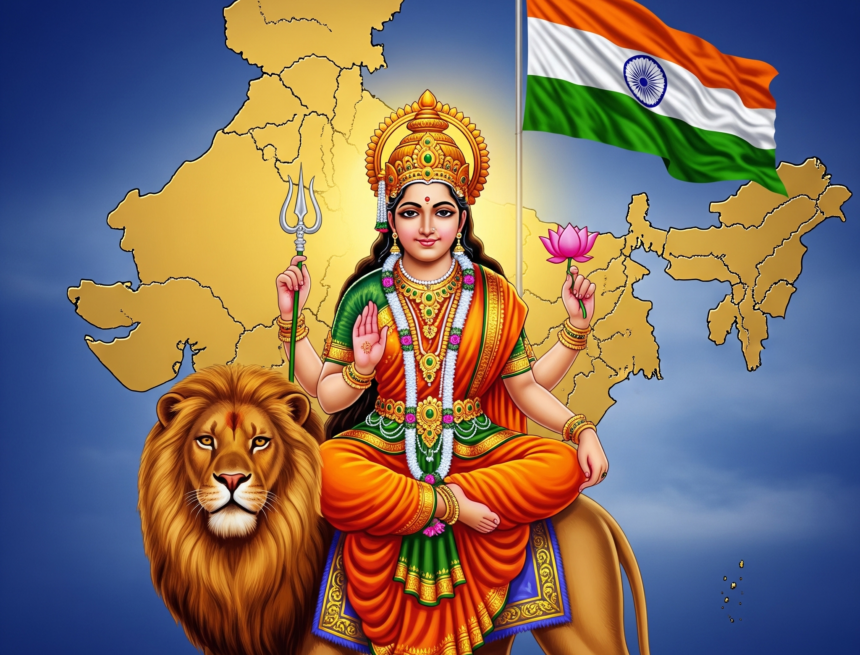Nestled in the sacred hills of Tirumala, Tirupati is more than a pilgrimage — it is a living legacy of devotion and divine grace. From ancient Pallava endowments to the grandeur of the golden roof of the sanctum sanctorum donated by Krishna Deva Raya, its history is etched in every gopuram. Always reverbating with the chants of “Govinda”, for millions in South India, it is not just a temple, but an inseparable part of life’s journey.
Latest Posts

Bonalu – The Living Goddess Traditions of Telangana
Bonalu is more than a festival—it’s the heartbeat of Telangana’s devotion to the Mother Goddess. Rooted in ancient village traditions and the worship of Grama Devatas, it transforms Hyderabad into a living tapestry of devotion, ritual and culture. From trance-induced prophecies to the fierce dance of Pothurajus, every moment is an embodiment of Shakti — both protective and powerful.

Harihara, Bukka, and the Birth of Vijayanagara
At a time when Muslim invasions had devastated much of North India and were sweeping into the South, two brothers—Harihara and Bukka—guided by the sage Vidyaranya, laid the foundation of the Vijayanagara Empire in 1336. More than a kingdom, it became a bastion of Hindu dharma, shielding the South for over two centuries. This is the story of its origins and enduring legacy.

The Limits of Equality: A Dharmic Appraisal of Modern Political Theology
Modernity universalizes Enlightenment ideals of equality, recasting Dharmic order as moral failure. But in Dharma, justice lies not in sameness, but in harmony—each being acting in accordance with its Svabhāva and Svadharma. The caste system, far from being a hierarchy of worth, was a framework of reciprocal duty, now misunderstood and maligned through colonial and liberal lenses. True reform lies not in dismantling tradition, but in reclaiming its wisdom with renewed understanding.

Bhārat’s Flag, Anthem and Name
In this article, Dr. Koenraad Elst reflects on how India's national symbols—its flag, anthem, and the very name Bharat—are deeply rooted in Hindu tradition. Elst argues that despite the secularist intentions of Nehruvian India, the Dharma Cakra in the flag, the reference to Ma Durga in the anthem, and the nation taking its name from King Bharata, reveal a cultural continuity that cannot be denied: that India, by heritage and spirit, remains a Hindu Rāṣṭra.
Daily Feed
Origin of Muslim Appeasement – Mahatma Gandhi and Moplah Rebellion
The Moplah rebellion gave rise to an era of Muslim pampering that has only become more nauseating with time.
An Indian Classics Curriculum
Classical Indian texts need to be introduced into the curriculum so that students are made aware of the massive strides their ancestors took in all fields of intellectual rigour.
The unpredictability of spiritual life
Jyotiṣa is a powerful and systematic method of predicting future events whose accuracy is highly dependent on the depth of the astrologer's intuition. However, it reaches its limits when it confronts adhyatmic (spiritual) dimensions of a person's life.
Is Indian Culture Obsolete?
Can Indian culture still feed its country's malnourished soul which has been decaying amidst the onslaught of western society's social norms and ethical values?
GLIMPSES OF FEMININE DIVINITY IN SANATAN DHARMA
In Hinduism, females and males are the two halves of 'one whole’ in the form of Shiva and Shakti. The Hindu scriptures extol the quality of the female divine as well as the spiritual equality among male and female deities, while highlighting the differences in their manifested forms.
Search for Savarkarite Conservatism
Was Vinayak Damodar Savarkar a conservative? Exploring this question, this article by Chandravir Pandey delves into Savarkar's concept of Hindutva, and its alignment with conservative principles. The essay also examines the paradoxes in labeling Savarkar a conservative, given his revolutionary zeal and progressive ideas.
Book review: Essence of the Fifth Veda by Gaurang Damani
Dr Pingali Gopal reviews Essence of the Fifth Veda, a captivating compendium by Gaurang Damani.
Buddha, Shankara and Vivekananda – Milestones of Indian spirituality
The three great sages of the Indic spiritual tradition, while reacting to the times they lived in, gave expression to the same truth in different ways.
The Ratha-Yatra Festival at Jagannatha Puri
A look at the significance of the Ratha Yatra festival, the awe inspiring Jagannatha Puri and the story behind how the deities appeared in their present form.
Goa – The roads less travelled
Away from the beaches of Goa, nestled within the verdant forests of western ghats, lie the hidden treasures of Goa's distant past.
Does Kantara depict women in bad light?
In this review of Kantara, Rohan Raghav Sharma tackles the allegations that the film depicts women in a poor light by analysing the actions of the key characters as well as scenes that may be interpreted as such.
गुरुओं की संरक्षा महत्वपूर्ण है
गुरु शिष्य परम्परा हिन्दू धर्मं की एक अचल कड़ी है जिस पर आक्रमण करके भारत विरोधी शक्तियां हमारी प्राचीन सभ्यता के ताने बाने को नष्ट करना चाहती हैं
Daily Feed
A legacy in bronze
The reign of the Chola empire was synonymous with artistic magnificence which still hypnotizes those who encounter it.
Garuda – A Unique Amalgamation of Power, Royalty, Divinity & Faith
This article, discusses Garuda, the vehicle of the mighty Vishnu; his presence and influence in iconography and symbology in Bharat and beyond.
A Tale of Two Resurrections
Ilayaraja's view on the resurrection of Jesus Christ compared to his beloved Ramana Maharshi has sparked debate.
On Audrey Truschke’s “Aurangzeb: The Life and Legacy of India’s Most Controversial King”
"Bridging the chasm between the historical Aurangzeb and this reimagined (and largely imaginary) Aurangzeb is a daunting task, but Truschke makes her case with the chirpy enthusiasm of an Aurangzeb fangirl writing a puff piece in People magazine on her idol.
The received historiography on Aurangzeb is riddled with outlandish hoaxes that have gone unchallenged for decades. Truschke’s book is a worthy addition to this genre since it refreshes our memories of these hoaxes while enthusiastically manufacturing new ones."
An incisive and witty review of Audrey Truschke's book on Aurangzeb, and her source material, by Keshav Pingali.
Breaking Colonial Mind-cuffs – How language has controlled the Hindu psyche
The multi-tier colonial legacy which India has inherited through language has been increasingly tough to dismantle.
The Millennium old 16-day Durga Puja in Odisha
Odisha is the land of Shakti Peethas and while people mainly associate Durga Puja with West Bengal, Odisha has its own unique celebration.
Mithila Art: A living tradition since the Ramayana
Madhubani Art has a rich history which is steeped in stories from the Ramayana and Mahabharata which till very recently was not known to most Indians.
Garuda and the State of Flow
When we combine the legend of Garuda from the Puranas with modern scientific perspectives, we can better understand the science of living in the now.
Understanding Indian Economy: Ancient To Modern – Part 4
The previous parts were an attempt to summarise the Indian economic story from its ancient roots until the end of British rule from various sources. The understanding of the Indian economy after independence also tends to be a little complex for a layperson to understand because of conflicting opinions. However, the overall story is one of hope and pride rather than shame and disappointment. This part also includes selected references and further readings for those interested.
Yantras – What is their purpose
Used in sadhana practices for worshipping deities, yantras are symbols of divine power which need to be installed with the use of specific mantras.
Caste in Medieval India: The Beginnings of a Reexamination
Caste in Hindus as a social stratification method has long been criticised without understanding how it operates within other religions.
Kolkata And Sunderbans – Diaries Of A Whirlwind Tour
Dr. Pingali Gopal recounts his travel and stay in and around Kolkata, delves into the history of the city and its landmarks and monuments, and touches the soul of the 'City of Joy' in this very intriguing travelogue.

